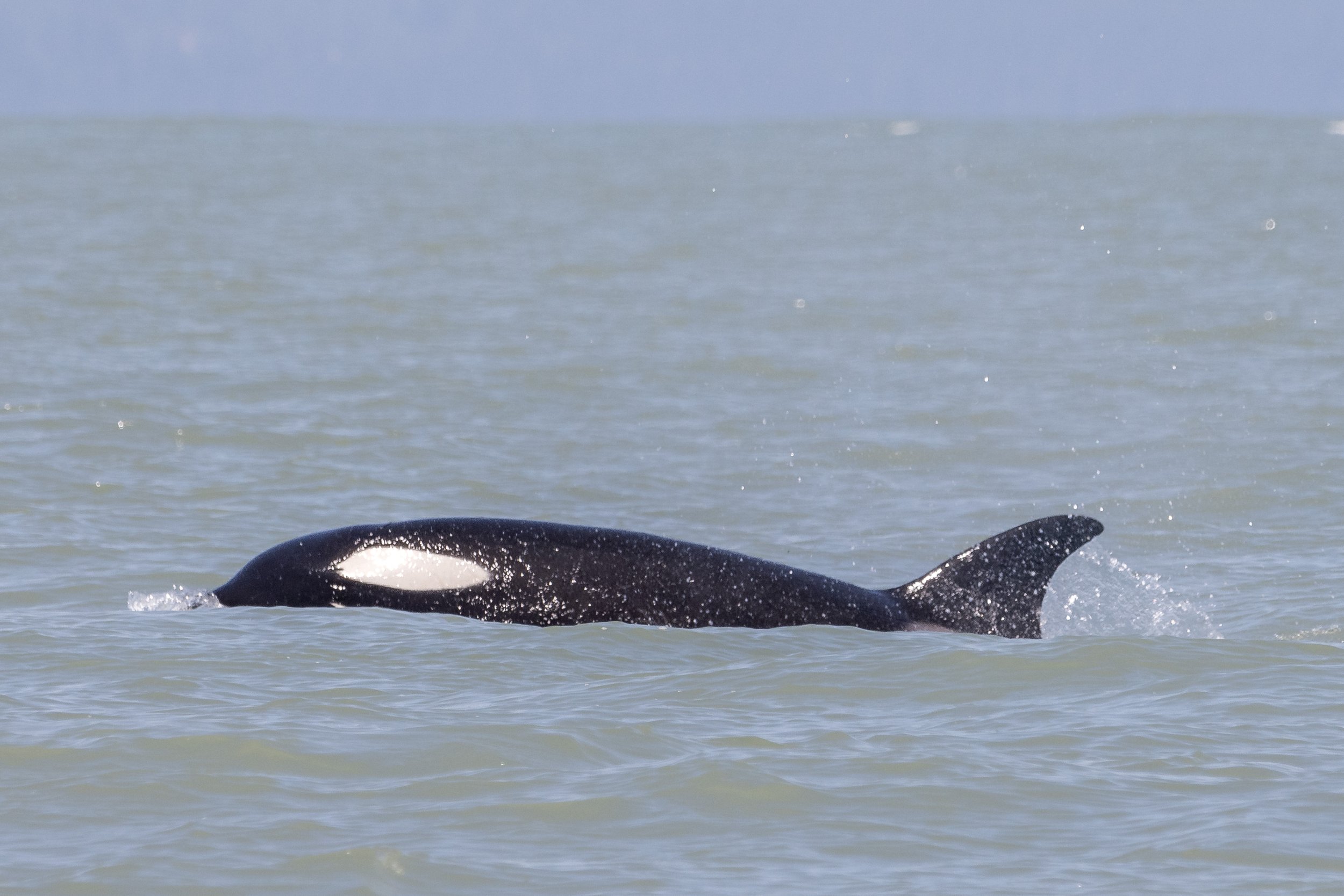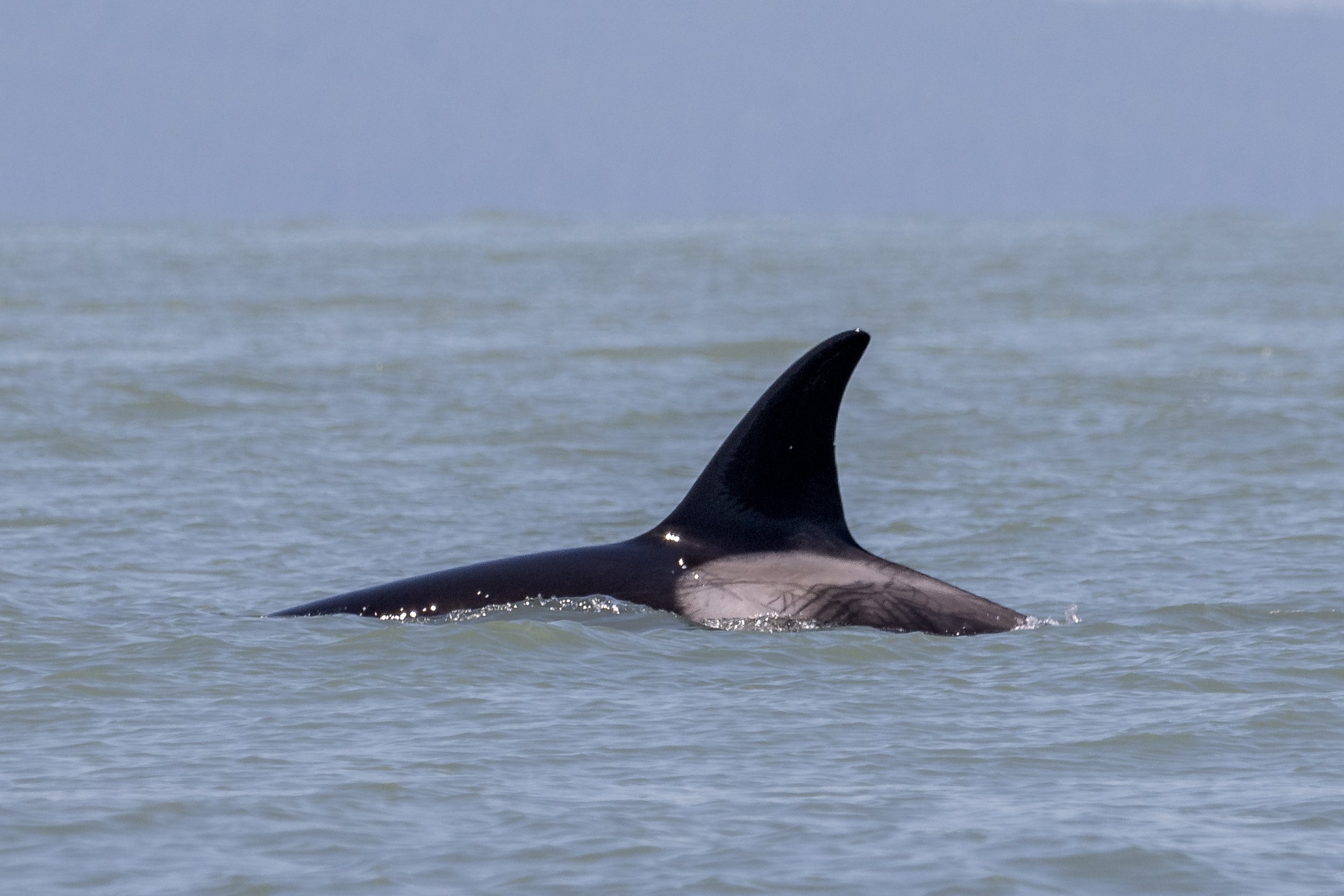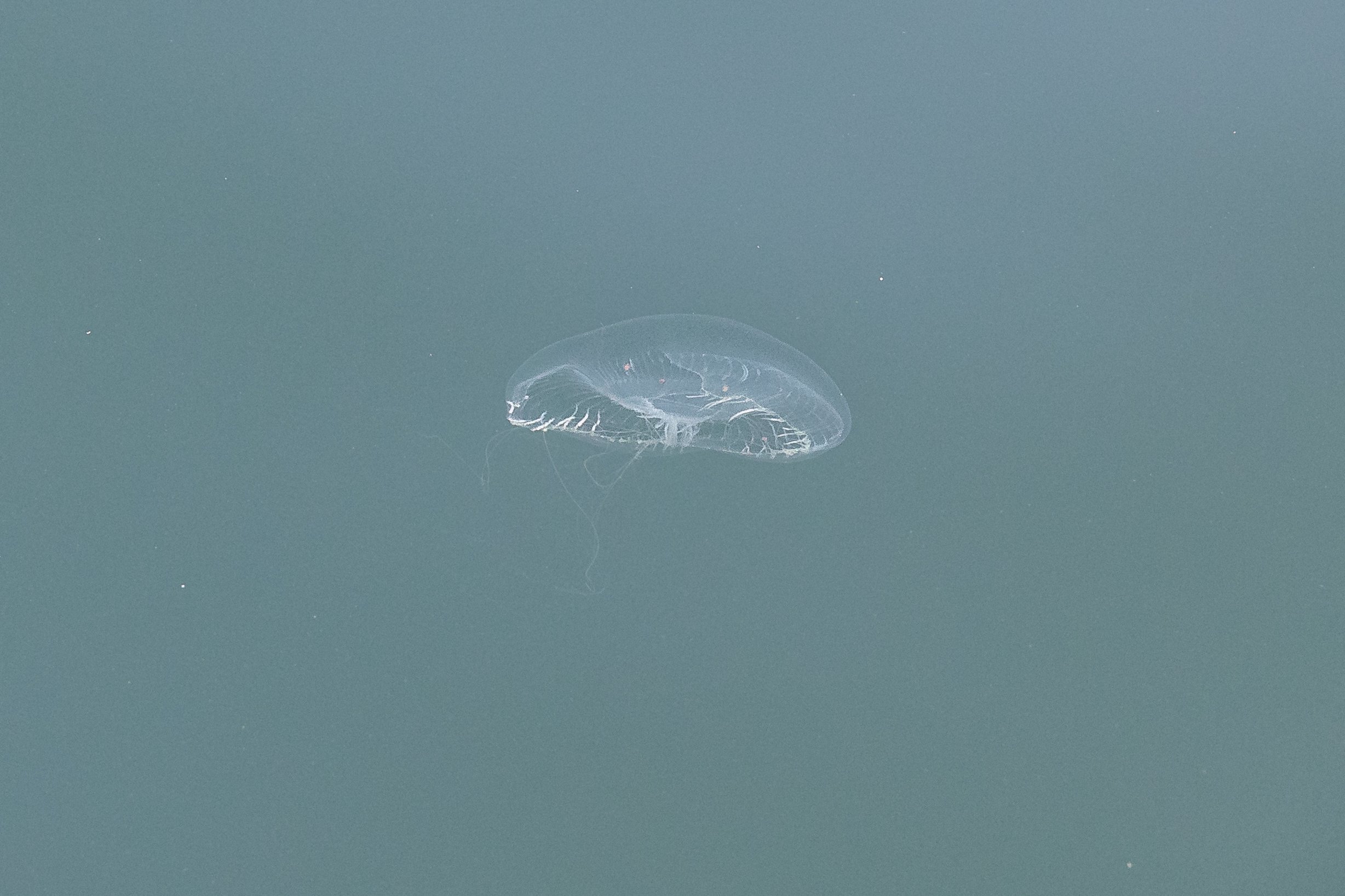July 15, 2024, 10:30 AM - We had a double double this morning, not the coffee, but the species!
After our Naturalists and Captains enjoyed their morning coffees, we wrangled all our guests up and headed down to the boats, with a full fleet out today! We pushed off the dock and each boat headed in a different direction. We do this so we can cover a larger area and increase our chance of finding the whales. None of the whales are tagged, tracked or chipped so we have to find them every day from scratch. Most of the time, we find animals just by sighting them ourselves, so that’s why our team needs our coffees! Bright-eyed and bushy-tailed, we started scanning for blows and fins. While our open boats searched the Strait, the semi-covered vessel Kula went to investigate a report off of UBC across the water. Just after leaving Nanaimo, the open boats found a humpback, and they were hard to miss!
This humpback was a familiar fin - it was BCY1107 Dandelion! We identify our humpbacks using their tails, but we can use their dorsal fin when we don’t get a fluke shot. Dandelion has a very distinct dorsal so we recognize them even before they fluke! Dandelion was easy to spot because they were pec slapping! This cool behaviour involves the animal rolling on their back or side while slapping their pectoral fins on the top of the water. This incredibly cool behaviour is also incredibly loud, both above and below water. Humpbacks may do this because they are excited, but it’s also a great form of communication between animals. Whatever the reason for Dandelion’s slapping, guests were treated to a great experience as those 20 foot pectorals splashed away!
On the other side of the water, Kula found the Orca that were reported earlier that morning. This group was pretty spread out, travelling just a few kilometers off the coast. The Orca spotted were:
T086A3 Tyndall ♀ (2011)
T086A3A (2024)
T124A2 Elkugu ♀ (2001)
T124A2A Agafia ♂ (2013)
T124A2B Litton ♀ (2016)
We had 2 pods today…well kind of. The T124A2s travel together under their matriarch Elkugu, Agafia and Litton are her son and daughter. T086A3 Tyndall used to travel with her mother T086A Eider along with her brothers and sisters, so why is she with the T124A2s? We think she may have chosen to leave her mother on her own, or she may have been kicked out! The T086As have been busy bees this year, with Eider (the matriarch), Tyndall and Nahanni (two sisters) all having calves this year right around the same time. We speculate the pod was getting crowded, with too many noisy babies, and lots of little mouths to feed. Our best guess is Tyndall decided to pod hop and perhaps she will be the next matriarch leading her offspring around the Salish Sea!
The sightings didn’t stop there though! Kula, our semi-covered vessel, found more humpbacks! This time it was BCY0994 Dalmatian along with Neptune (BCY1021). We had a treat instore as Dalmatian decided to get a little curious with us and approached the boat. This behavior is called mugging, it gets it’s name from the whale sticking their faces (mugs) out of the water near the boats. Seeing a giant this close up is thrilling, it is not everyday you get up close and personal with whale lice on that mug! After a heartwarming visit with these whales we headed off to meet some other members of the Salish Sea.
Afterwards we got to see the largest Sea lion in the world. These Steller sea lions get huge, with the males weighing as much as 2 regular horses! That is 2800 pounds. As it is pupping season for our Harbour seals we spotted some babies with their mothers! We watched a Pigeon Guillemot fish for a snack at the Bluffs, and that is also where we meet our Cormorants in their nests!
Photos by Marine Naturalists Cheyenne Brewster, Des Poier, and Lucy Willis.
T124A2 Elkugu and T124A2B Litton. Photo by Des Poier.
T124A2A Agafia. Photo by Des Poier.
T124A2 Elkugu and her youngest T124A2B Litton. Photo by Des Poier.
T086A3 Tyndall and her calf T086A3A. Photo by Lucy Willis.
T124A2B Litton. Photo by Lucy Willis.
T086A3 Tyndall. Photo by Lucy Willis.
T086A3 Tyndall and her calf T086A3A. Photo by Lucy Willis.
T124A2 Elkugu. Photo by Lucy Willis.
T086A3 Tyndall. Photo by Lucy Willis.
T086A3A. Photo by Lucy Willis.
T086A3A. that little eyepatch is so cute! Photo by Lucy Willis.
T124A2 Elkugu and T124A2B Litton. Photo by Lucy Willis.
T124A2 Elkugu. Photo by Lucy Willis.
T124A2A Agafia. Photo by Lucy Willis.
BCY1107 Dandelion. Photo by Lucy Willis.
Dandelion showing off their pectoral fin. Photo by Lucy Willis.
Dandelion’s pec. Photo by Des Poier.
Dandelion’s fluke. Photo by Lucy Willis.
Dandelion defecating. Photo by Des Poier.
Neptune surfacing. Photo by Cheyenne Brewster.
BCY0994 Dalmatian. Can you see the little whale lice? Photo by Cheyenne Brewster.
Neptune’s dorsal fin. Photo by Cheyenne Brewster.
The water has been gorgeous lately! Here you can see part of this whale underwater. Photo by Cheyenne Brewster.
The red in the water is actually whale poop! Whale poop is super important for helping plankton populations! Photo by Cheyenne Brewster.
Dalmatian. Photo by Cheyenne Brewster.
Dalmatian diving. Photo by Cheyenne Brewster.
The back of the fluke isn’t as helpful for ID-ing, but we can tell this is Dalmatian from the shape. Photo by Cheyenne Brewster.
Dalmatian. Photo by Cheyenne Brewster.
The underside of Dalmatian’s fluke. Photo by Cheyenne Brewster.
These bumps are called tubercles! Each one has a small hair sticking out of it. Photo by Cheyenne Brewster.
A nice closeup of those tubercles. Photo by Cheyenne Brewster.
Look at that pretty smile! Photo by Cheyenne Brewster.
Those white, circular marks are from barnacles. Photo by Cheyenne Brewster.
Can you see the pectoral fin underwater? Photo by Cheyenne Brewster.
Dalmatian’s pec fin. Photo by Cheyenne Brewster.
Some fun patterning on Steller Sea Lions from the splashing. Photo by Des Poier.
A big male sea lion posing. Photo by Des Poier.
A mom Harbour Seal and her pup. Photo by Des Poier.
A bunch of Harbour Seals, or what we like to call them, Rock Sausages! Photo by Des Poier.
Cormorants preening and a seagull trying to fit in. Photo by Des Poier.
A Pigeon Guillemot with a sculpin in it’s mouth! Photo by Des Poier.
A jellyfish! These clear ones will not sting you if you do end up touching them, but if it’s red or looks like an egg, it will sting. Photo by Cheyenne Brewster.










































